|

LEARN TO JUGGLE
TO LEARN
THE BASICS OF THREE BATON
You can learn to juggle anywhere, but we recommend making use of a table, preferably of
a height between your kneecaps and your waist (your kitchen table will probably do fine).
Clear away the chairs and stand so you're brushing against it, facing forward. Using a
table has two advantages: it means you don't have to stoop as far to pick up dropped
balls, and you'll learn good habits by confining your juggling to a more-or-less fixed
area.
The role of rhythm
Toss one ball up and catch it with the same hand. Keep doing it for several
minutes. See how there's a rhythm to it? Try standardizing the height of the toss, making
each one send the ball at more or less the same height and location. With a little
practice it should be easy to make the ball go up and down monotonously. But notice that
monotony--see how the rhythm has become stronger?
Eventually, that rhythm will help you tell where balls are in the air, just as surely
as your eyes will. That's because the rhythm corresponds to the amount of time each ball
is in flight. Toss a ball higher or lower and you'll get a different rhythm.
Relying on peripheral vision
Keep tossing. But now, instead of concentrating on the ball, try paying attention to
your hand (the one that's doing the tossing). Eventually you'll observe something
important. The fact that you can look at your hand and still keep track of the
ball's progress.
This might take a while, but it'll come. It's peripheral vision at work; and an ability
you'll soon strengthen.
People often wonder which ball a juggler looks at when juggling. The answer? None.
They are usually not tracking the motion of any particular ball, just trusting to
peripheral vision to get a working sense of them all at once.
The tossing position IS the
catching position
This is an observations that can make a huge difference in understanding what juggling
is all about. Look at what happens to your hand in terms of its physical position: not
much, right? You cup your hand to toss and it stays cupped for the catch. The position for
both is essentially the same.
Why is this important to grasp? Because as soon as you start juggling, you'll find one
ball coming in for a landing just as you've given another its flight. You won't panic and
get boggled if you know your hands are already in the optimal position to do both. You'll
simply toss one ball to clear your palm for the incoming one, and next thing you know
you'll be juggling.
The abundance of free time
Now that you're looking at your hand, notice how little time it's actually occupied
with the ball. It's really got lots of leisure opportunities, doesn't it, so long as it's
there to catch the ball when it returns. Heck, at least half the time your hand is
actually empty!
Much of juggling is simply taking advantage of that time. Here's an experiment.
Keep tossing, but this time try snapping your fingers while the hand is otherwise
unoccupied. Don't try to turn tossing and snapping into a single hurried motion--you'll
find there's plenty of time to do both. You should be able to toss, snap, then reopen your
palm and let the ball fall back in. If you can do this, congratulations: you've just
mastered a skill that, in motor coordination terms, is every bit as difficult as juggling
itself.
The moment of apogee
Notice how the ball reaches its highest point, then stays suspended for a fraction of
a second before it heads back down? That moment--the split second before gravity takes
over--is the apogee, and it's the juggler's friend. When you graduate to multiple
balls, you'll use it as your timer. When one ball reaches its apogee, it's time to throw
the next. Three-ball jugglers never, ever have to do anything at any other time.

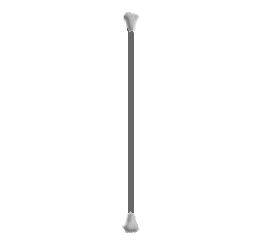
Next exercise: when you toss the ball, try to visually pinpoint the moment of apogee.
Now try saying the word "beep" every time your ball hits apogee (aren't you glad
you're doing this in private?). After several dozen "beeps," you can graduate to
the next step. Instead of vocalizing, try snapping your fingers on your other hand (the
one not tossing) at that moment.
Now you've got a handle on timing. Quite soon now, you'll be substituting that action
(the fingersnap) for the action of tossing a second ball. Do you see why one ball's apogee
is another's ideal launching moment? Because it doesn't disturb the rhythm.
Tossing doesn't require much
movement
To send that ball repeatedly up over your head, how much motion does it really take on
your part? All you really need to do is push your hand up smartly and keep your palms
open. Try keeping extraneous movement to a minimum. In the beginning you'll be lunging all
over catching stray tosses, but as your tossing gets consistent you'll find you need to
move only the area from your elbows to your hands. Let momentum and gravity do most of the
work.
We've got a little more single-ball work to do before the fancy stuff. This warrants a
step of its own because you'll be mastering a new skill: tossing a ball back and forth
from one hand to the other. Sure, you can probably do that right now, but you'll need to
streamline your technique for juggling.
Take the ball and toss it up in the air, as in the previous step. Only this time angle
your hand slightly--just enough to send it sailing not in a straight up-and-down path, but
in a gentle arc to your other hand. While practicing this, keep these thoughts in mind:
-
The key word is "toss"
You're NOT throwing the ball at your other hand, you're letting its arc spread so that
its launching and landing are two different points. Toss it no harder or softer than you
did in Step 2 and keep your hand and arm motions as vertical as before. You'll find just
the slightest angling of the hands is all it takes for ball's path to stretch out so that
it travels to the territory of your other hand. We repeat: don't throw, just toss up with
a slight angle.
-
Trust in the apogee Focus
your attention on the ball when it hits the point of apogee: that's how you'll know
exactly where the ball is going to land. It's like this. The arc of a ball is a
perfect curve, and the path taken to get to apogee is ALWAYS
mirrored, in exact reverse order, by the remainder of the arc. What comes down equals what
goes up.
That means the behavior of the ball in reaching its apogee is a preview of
what's going to happen next. If a ball hits apogee at a sharp angle two feet away from the
throwing hand, that means it'll come down at an equally sharp angle four feet from the
point of origin. Catching it is simply a matter of positioning your hand.
You'll note that the gentler the arc, the less pronounced the apogee--because it
doesn't have to reverse direction, the ball doesn't seem to stop in midair at any point.
But you'll still know it instinctively: it's when the ball's flight stops being upward and
starts being downward.
-
Use your peripheral vision.
This simple fact of physics--the first part of the arc is the exact opposite of the last
part--is at the heart of many of the impressive aspects of juggling. It's why jugglers
seem to snatch balls out of midair, without even looking. They don't need to see where
it's going, because they know where it's been.
It's easier than it seems. Try this
experiment: cast your eyes upwards, in the general area where most of the apogees seem to
occur. Pick a spot on the ceiling and keep your eyes there. Try not to move your head,
just trusting to peripheral vision and your sense of apogee.
Now toss and catch your ball, without looking at either hand. You probably won't get it
at first, but with a little practice you'll find you can watch the ball sail through your
field of vision and adjust your catching hand accordingly. Just fight the temptation to
track the ball through its complete arc, and trust in your hand's innate sense of
position. After all, isn't this just a variation on what baseball outfielders do? They get
a sense of the ball's arc, then place their mitts underneath while still looking skyward.
-
Practice in both directions.
You've probably been favoring one hand throughout your practice, and why not?
You've only needed one up 'til now. But juggling is a bi-directional activity, and you'll
be tossing and catching equally with both hands. It doesn't matter which hand you use to
start your toss/catch routine, but now's the time to even out the flow. Keep the one bag
shuttling back and forth as much as possible. To get comfortable with this motion (and to
strengthen your peripheral vision), just look casually around the room while you're doing
it..
Once you get the hang of this, it's time to move on to some actual juggling!

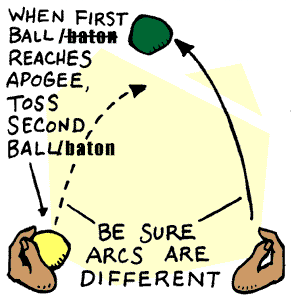

Ready to start juggling?
You're going to master the basic mechanism in this step, even though you're still a few
steps from tackling all three balls. Let's move up to two for now.
What's "the basic mechanism"? It's what we noted in the introduction as
"the simple act of throwing a ball in such a way as to leave your hand open to catch
another." Our term for this action is the jug.
First, warm up by doing your arc-toss again of a single ball from one hand to another.
By now you should have both throwing and catching pretty well down: the tosses are all
pretty consistent, and you don't have to move much to catch them--and when you do move,
you're moving your arms and not your whole body.
Now, do the same thing...only this time, hold a ball in each hand. Hand One
tosses a ball to Hand Two--but oops, Hand Two is already occupied with a ball. What does
it do?
It gets rid of its current ball...by throwing it in an arc that just happens to take it
in the vicinity of Hand One. That's a jug.
At about this point, it's natural for panic to set in: When do I throw it? How do I
keep the balls from hitting? Relax.
You throw it when the first ball is at its apogee--remember that second exercise you
did with snapping fingers?
Your balls won't collide, because you can judge the arc of Ball One precisely. You
simply toss Ball Two in a slightly different arc, one that takes it on a path to the
inside of the other. You'll find that only an incredibly slight inward tilt of the wrist
is all it takes to alter the arc.
In the beginning, don't even try to catch the second ball. Just focus on how the second
hand clears itself by tossing what it currently holds.
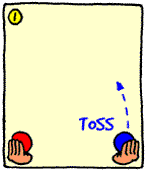 
Okay, now we're getting to the point where illustrations make the point
more clearly than words. The next step is to simply repeat the "jug" in
alternate directions, as in the image below. With a little practice, you should be able to
catch the balls every time.
 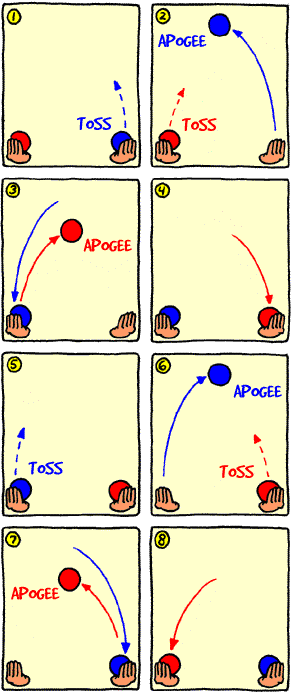 
As you practice, keep in mind that the hard part is past you now. Once you get the hang
of throwing and clearing with the same hand, you've perfected the mechanism of juggling.
Got the "double jug" down? Good. You are now on the threshold of becoming a
full-fledged juggler. It's time to introduce the third and final ball.

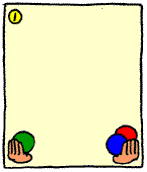

Real juggling is no more complicated than the double jug, except that for the starting
toss you've got to hold two balls in one hand. That shouldn't be too hard: try holding
them side by side (as in the illustration), and keep a grasp only on the one you want to
stay.

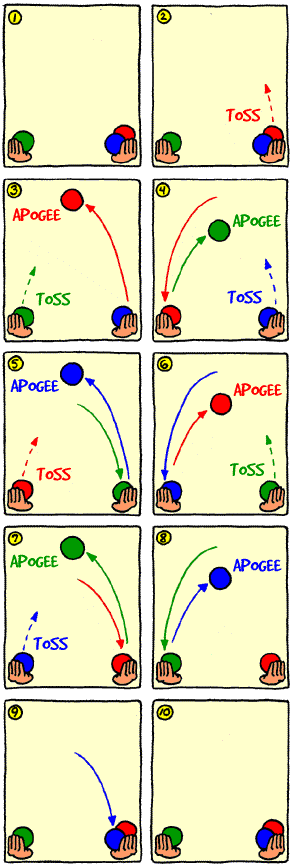

Which hand should you launch from? In general, it's probably easiest to go start from
your "handed" hand--i.e., if you're right-handed, start with your right hand,
etc.
Eventually you should be able to start from any direction, but it's sort of a moot
point: once the initial ball has been tossed, the pattern is exactly the same: ball gets
tossed. At its apogee, next ball gets tossed. At ITS apogee, next ball...and so on and so
forth.
At first, it'll take some perseverance to keep the juggling going beyond a few seconds.
That's usually because chaos intrudes into your carefully-established order: one ball
wanders a little too far, and in moving your hand to catch if you throw off the arc of the
next, and so forth until you find yourself wildly grabbing at thin air.
Relax. This is a necessary phase, and not a sign that you weren't cut out for this sort
of caper. Work on the regularity of your tosses and catches, and when things start going
wild, don't break your rhythm and range of motion to accommodate them. Just let the ball
fall short or long, pick it up and start again. You're in charge here, and the goal isn't
to keep the balls in the air at all costs, but to find your own pace.
Hooray! Even if you can only keep 'em up for a few seconds, you're now an official
juggler. What you've been working on is the primary juggling pattern, often called the
"basic cascade." Once you're thoroughly comfortable with it, you might want to
try these variations on the three-ball theme: try tossing all of them in big overhand
loops, or reversing direction suddenly. You can also do a double jug in a single hand,
sending two balls up and down in that hand while you do mischief with the other (this is
how the old eating-a-juggled-apple trick is done).
HAPPY JUGGLING!
TIPS
& TECHNIQUES HOME
|







